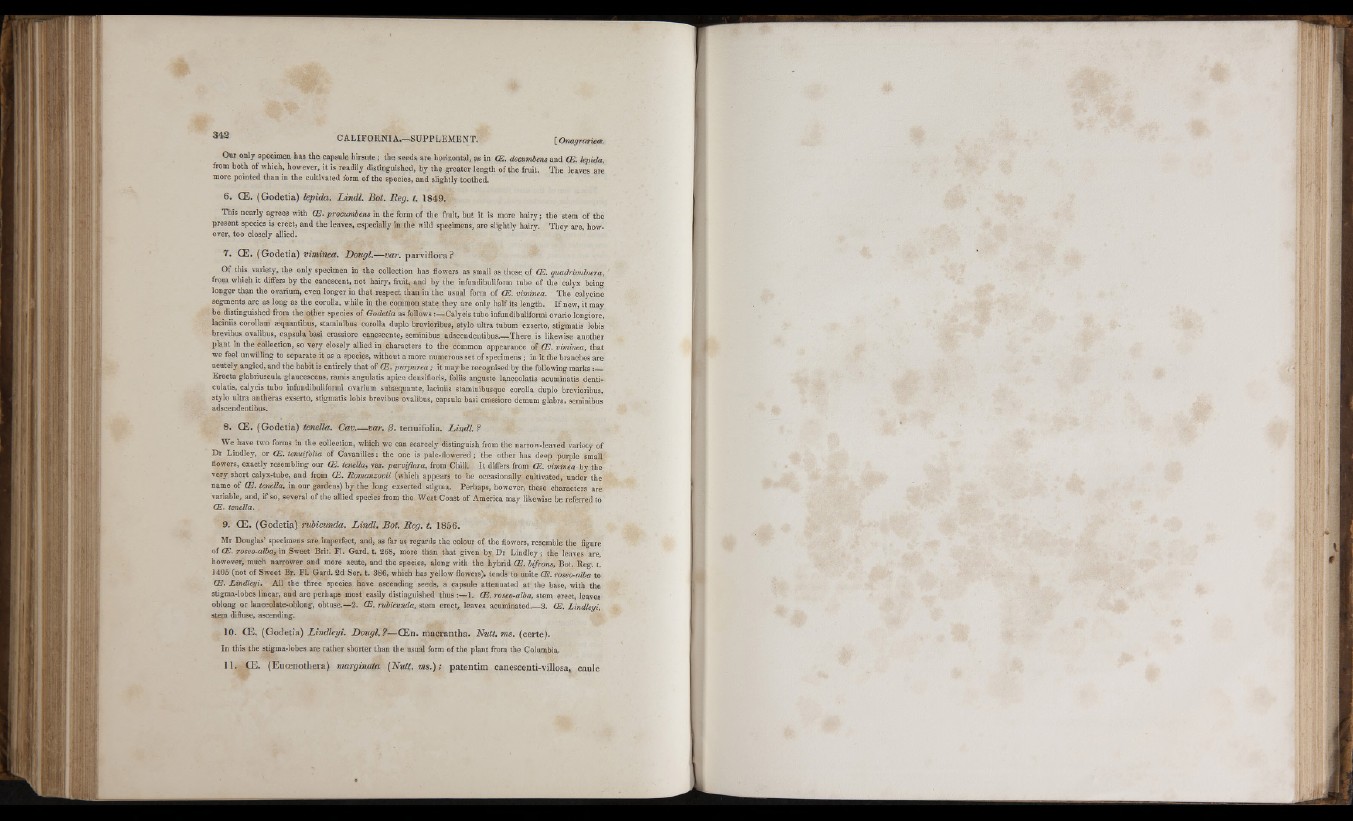
:
i' ■
V '
•• i
1,
to
Our only specimen has the capsule hirsute; the seeds are horizontal, as in OE. decumbens and OE. l^ id a ,
from both of which, however, it is readily distinguished, by the greater length of the fruit. Tlie leaves are
more pointed than in the cultivated form of the species, and slightly toothed.
6. OE . (Gode tia ) lepida. L in dL Bat. Reg. t . 1849.
This nearly agrees with OE. procumbens in the form of the fruit, but it is more hairy ; the stem of the
present spedes is erect, and the leaves, especially in the wild specimens, are slightly hairy. They are, how.
ever, too closely allied.
7. OE . (Go d etia ) viminea. Dougl.— var. parviflora?
Of this variety, the only specimen in the collection has flowers as small as those of OE. quadrividnera,
from which it differs by the canescent, not hairy, fruit, and by the infundibuliform tube of the calyx being
longer than the ovarium, even longer in that respect than in the usual form of OE. viminea. The calycine
segments are as long as the corolla, while in the common state they are only half its length. I f new, it may
be distinguished from the other species of Godetia as follows Calycis tubo infundibuliformi ovario longiore,
laciniis corollam æquantibus, staminibus corolla duplo brevioribus, stylo ultra tubum exserto, stigmatis lobis
brevibus ovalibus, capsula basi crassiore eanescente, seminibus adscendentibus There is likewise another
plant in the collection, so very closely allied in characters to the common appearance of OE. viminea, that
we feel unwilling to separate it as a species, without a more numerous set of specimens ; in it the branches are
acutely angled, and the habit is entirely that of OE . purpurea ; it may be recognised by the following marks
Erecta glabriuscula glaucescens, ramis angulatis apice densifloris, foliis anguste lanceolatis acuminatis denticulatis,
calycis tubo infundibuliformi ovarium subæquante, laciniis staminibusque corolla duplo brevioribus,
stylo ultra antheras exserto, stigmatis lobis brevibus ovalibus. capsula basi crassiore demum glabra, seminibus
adscendentibus.
8. OE . (Godetia) tenella. Cav var. fi. tenuifolia. L in d l.?
We have two forms in the collection, which we can scarcely distinguish from the narrow-leaved variety of
Dr Lindley, or OE. tenuifolia of Cavanilles : the one is pale-flowered ; the other has deep purple small
flowers, exactly resembling our OE. tenella, var. parviflora, from Chili. It differs from OE. viminea by the
very short calyx-tube, and from OE. Romanzovii (which appears to be occasionally cultivated, under the
name of OE. tenella, in our gardens) by the long exserted stigma. Perhaps, however, these characters are
variable, and, if so, several of the allied species from the West Coast of America may likewise be referred to
OE. tenella.
9. OE . (Godetia) rubicunda. L in d l. Bot. Reg. t. 1856.
Mr Douglas’ specimens are imperfect, and, as far as regards the colour of the flowers, resemble the figure
of OE. roseo-alba, in Sweet Brit. FI. Gard. t. 268, more than that given by Dr Lindley ; the leaves are,
however, much narrower and more acute, and the species, along with the hybrid OE. bifrons, Bot. Reg. t.
1405 (not of Sweet Br. Fl. Gard. 2d Ser. t. 386, which has yellow flowers), tends to unite OE. roseo-alba to
OE. Lindleyi. All the three species have ascending seeds, a capsule attenuated at the base, with the
stigma-lobes linear, and are perhaps most easily distinguished thus 1. OE. roseo-alba, stem erect, leaves
oblong or lanceolate-oblong, obtuse.—2. OE. rubicunda, stem erect, leaves acuminated 3. OE. Lindleyi,
stem diffuse, ascending.
10. CE. (Godetia) Lindleyi. Dougl.?— CEn. macrantha. Nutt. ms. (certe).
In this the stigma-lobes are rather shorter than the usual form of the plant from the Columbia.
11. CE. (E uoen o tliera ) marginata {Nutt, ms.) ; p aten tim canescenti-villosa, caule